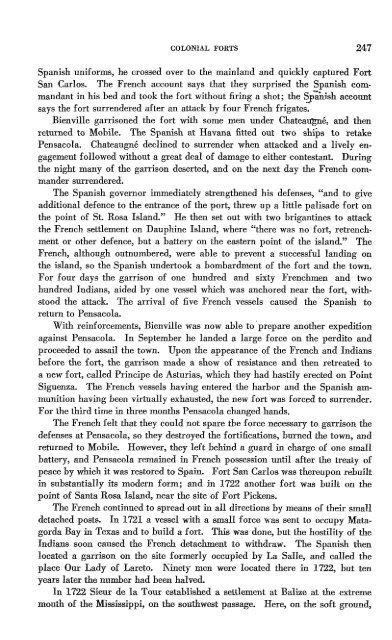THE COAST ARTILLERY JOURNAL - Air Defense Artillery
THE COAST ARTILLERY JOURNAL - Air Defense Artillery
THE COAST ARTILLERY JOURNAL - Air Defense Artillery
You also want an ePaper? Increase the reach of your titles
YUMPU automatically turns print PDFs into web optimized ePapers that Google loves.
COLONIAL FORTS 247<br />
Spanish uniforms, he crossed over to the mainland and quickly captured Fort<br />
San Carlos. The French account says that they surprised the Spanish commandant<br />
in his bed and took the fort without firing a shot; the Sp~nish account<br />
says the fort surrendered after an attack by four French frigates~<br />
Bienville garrisoned the fort with some men under Chateattgne, and then<br />
returned to Mobile. The Spanish at Havana fitted out two ships to retake<br />
Pensacola. Chateaugne declined to surrender when attacked and a lively engagement<br />
followed without a great deal of damage to either contestant. During<br />
the night many of the garrison deserted, and on the next day the French commander<br />
surrendered.<br />
The Spanish governor immediately strengthened his defenses, "and to give<br />
additional defence to the entrance of the port, threw up a little palisade fort on<br />
the point of St. Rosa Island." He then set out with two brigantines to attack<br />
the French settlement on Dauphine Island, where "there was no fort, retrenchment<br />
or other defence, but a battery on the eastern point of the island." The<br />
French, although outnumbered, were able to prevent a successful landing on<br />
the island, so the Spanish undertook a bombardment of the fort and the town.<br />
For four days the garrison of one hundred and sixty Frenchmen and two<br />
hundred Indians, aided by one vessel which was anchored near the fort, withstood<br />
the attack. The arrival of five French vessels caused the Spanish to<br />
return to Pensacola.<br />
With reinforcements, Bienville was now able to' prepare another expedition<br />
against Pensacola. In September he landed a large force on the perdito and<br />
proceeded to assail the town. Upon the appearance of the French and Indians<br />
before the fort, the garrison made a show of resistance and then retreated to<br />
a new fort, called Principe de Asturias, which they had hastily erected on Point<br />
Siguenza. The French vessels having entered the harbor and the Spanish ammunition<br />
having been virtually exhausted, the new fort was forced to surrender.<br />
For the third time in three months Pensacola changed hands.<br />
The French felt that they could not spare the force necessary to garrison the<br />
defenses at Pensacola, so they destroyed the fortifications, burned the town, and<br />
returned to Mobile. However, they left behind a guard in charge of one small<br />
battery, and Pensacola remained in French possession until after the treaty of<br />
peace by which it was restored to Spain. Fort San Carlos was thereupon rebuilt<br />
in substantially its modern form; and in 1722 another fort was built on the<br />
point of Santa Rosa Island, near the site of Fort Pickens.<br />
The French continued to spread out in all directions by means of their small<br />
detached posts. In 1721 a vessel with a small force was sent to occupy Matagorda<br />
Bay in Texas and to build a fort. This was done, but the hostility of the<br />
Indians soon caused the French detachment to withdraw. The Spanish then<br />
located a garrison on the site formerly occupied by La Salle, and called the<br />
place Our Lady of Lareto. l\inety men were located there in 1722, but ten<br />
years later the number had been halved.<br />
In 1722 Sienr de la Tonr established a settlement at Balize at the extreme<br />
mouth of the Mississippi, on the southwest passage. Here, on the soft ground,
















